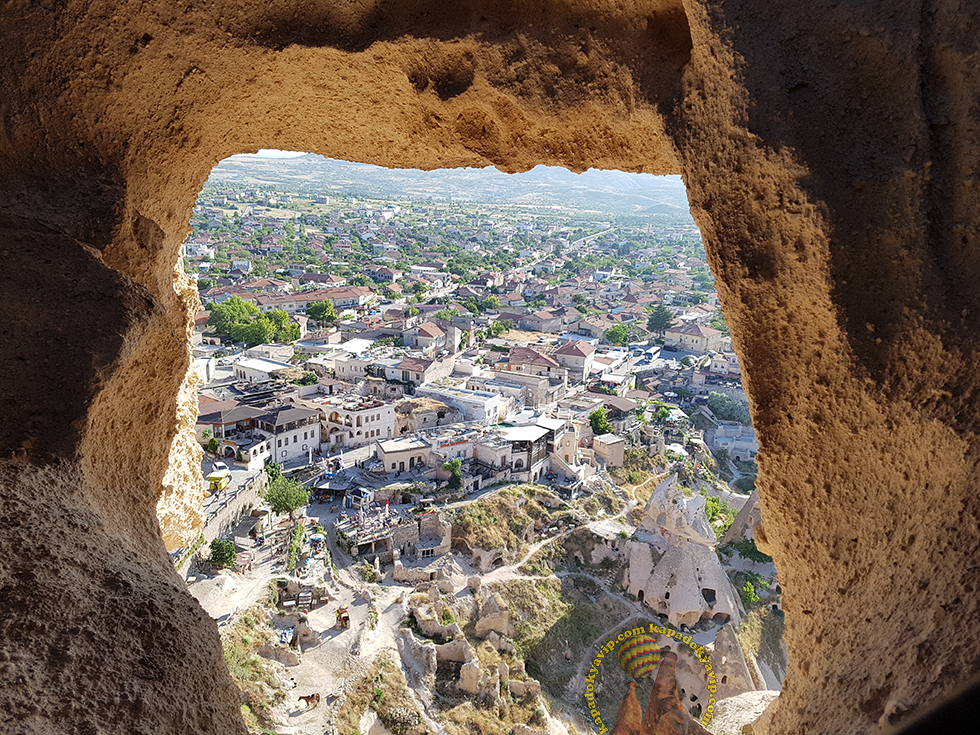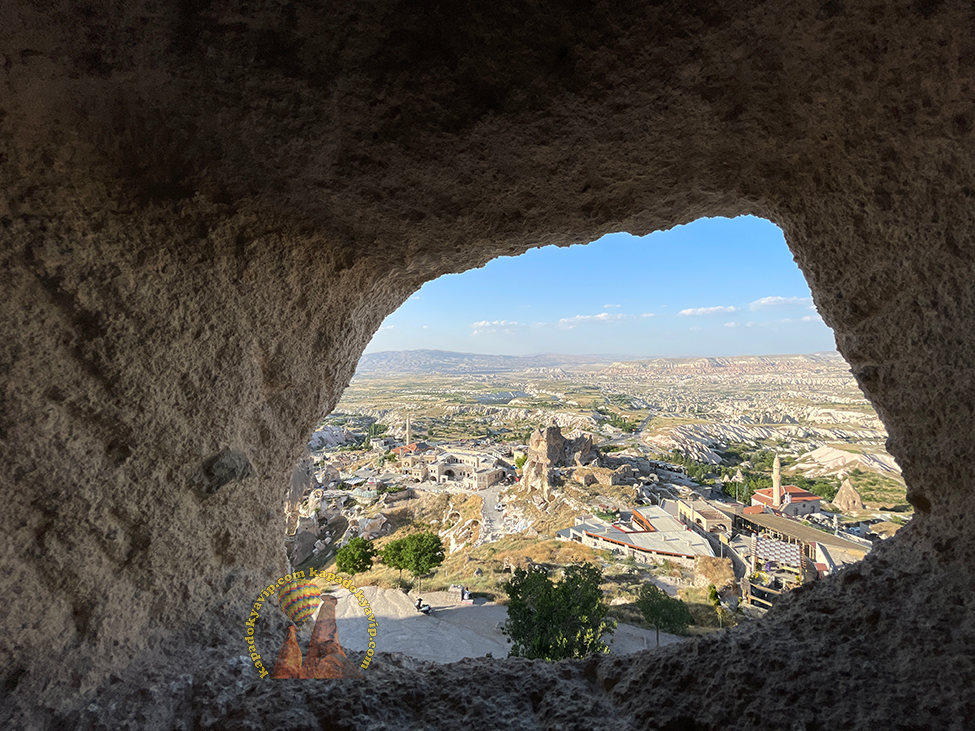
Cappadocia is a region whose boundaries were drawn in ancient times and has hosted numerous civilizations for thousands of years. While today, when Cappadocia is mentioned, Nevşehir and its districts come to mind first, it also encompasses Kırşehir, Kayseri, Akhisar, and Niğde.
Cappadocia geological history dates back to around 60 million years ago. During this period, with the uplift of the Taurus Mountains, the volcanoes in the region became active. The continuous eruptions over thousands of years led to the drying up of water in the area. After the volcanoes became dormant for a long time, the lava formations were shaped by the influence of rivers. The result is the fairy chimneys, which are extremely rare worldwide. With the advent of humanity, some of these fairy chimneys were carved and various structures were built. Today, they attract considerable interest from tourists, contributing to Cappadocia becoming a tourism paradise.
Research on Cappadocia indicates that there was human habitation in the region until around 2000 BCE, and it played a significant role in the development of important civilizations. In ancient times, it was under the dominance of the Assyrians. During this period, the country’s traders turned Cappadocia into a trade center. Today, there are still artifacts and cultural remnants from this period.
After the Assyrians, the territory belonged to the Hittites and Phrygians. Later, the Persian Empire annexed Cappadocia to its territories, and during this period, it was known as Katpatuka.
In the 300s BCE, it was conquered by Alexander the Great, and during this time, Cappadocia became one of the most important regions in Anatolia. Subsequently, the Kingdom of Cappadocia was established in the region.
The Kingdom of Cappadocia lasted for approximately 100 years. After its fall, Cappadocia became a province under Roman rule. During the Roman Empire period, it played a significant role in the spread of Christianity. Many religious figures retreated to this region, and various religious schools were opened, contributing to Christian missionary activities. After the division of the Roman Empire, Cappadocia became part of the Byzantine Empire.
Cappadocia came under Turkish rule during the Seljuk period in 1072. The region, which had been linked to the Seljuks, was later taken over by the Ottoman Empire in the 1400s.
Cappadocia is a region famous not only within the country but globally for its historical structures and natural beauties. Endowed with various mysteries, historical textures, and unique landscapes, Cappadocia opens its doors to millions of visitors each year. The Cappadocia region can be explored in detail through professional guides. It is truly the cradle of civilizations, having hosted many different cultures and directly witnessed history. Therefore, each square inch of Cappadocia contains unique structures and different stories.
Cappadocia was formed some 60 million years ago by the lava expelled from Güllü Dağ, Erciyes Dağı, and Hasan Dağı. Over millions of years, rain and winds gradually shaped it into its current form. Nature, with its long effort, has embroidered the region like a tapestry with fairy chimneys. The magnificent structure we see today has been formed through years of erosion. Nature has showcased its own art in this region. Even today, fairy chimneys, standing proudly, can be observed throughout the region, demonstrating nature’s craftsmanship.
Cappadocia historical roots can be traced back to the Paleolithic periods. It is estimated that the first settlements were established during this time. After this period, the reactivation of volcanoes prevented human settlements for an extended period. This situation continued until the Neolithic period. Excavations on Avla Hill near Ürgüp have revealed obsidian and flint stone tools, determined to belong to the Neolithic periods. Subsequently, the Silk Road once again brought a significant period of prosperity to Cappadocia.
Chronologically speaking, the oldest civilization to have lived within the borders of Cappadocia is the Assyrians. They conducted their initial commercial activities at Kayseri Küllütepe and Hattusha Karum. This period marks the first appearance of writing in Anatolia. The cuneiform texts, known as Cappadocian tablets, are associated with trade and marriage regulations. The foundation of Hittite civilization’s art was laid in conjunction with this civilization. They were a civilization that carried worship and divine ideas to Anatolia, holding a prominent position among the civilizations of Cappadocia.
Following the Assyrians, the Hittites established a vast civilization over Cappadocia. The capital of the Hittites, which evolved into a mighty empire, became Hattusha. Those interested in acquiring intriguing information about Cappadocia can delve into the history of civilizations in the region. All the civilizations that existed here have left quite fascinating traces, contributing to the formation of the splendid Cappadocian region we see today.
The Hittites, who left their marks almost everywhere in the Cappadocian region, are of utmost importance in Cappadocian history. They have been a civilization with a remarkably long lifespan, leaving their imprint in every inch of Cappadocia. They left monuments near important passages and rivers, marking their reached boundaries and the paths they traversed with their stories. The dates when underground cities were laid out for defensive purposes in the Cappadocian region also coincide with the Hittite era. The Hittite era holds great significance for the Cappadocian region.
Frigians are among the civilizations that contributed to the Cappadocian region. In brief, the most important information about Cappadocia is that it is the cradle of civilizations. Due to hosting many civilizations, Cappadocia has numerous traces and historical textures. Along with its unique nature, it is an exceptional region. This significant area, which is on the route of every traveler, holds a very important place worldwide.
With the entry of the Phrygians onto the historical stage, the Hittite cities located within the boundaries of Central Anatolia were gradually destroyed. The Late Hittite Period began in Central and Southeast Anatolia during this time.
The Assyrians named Cappadocia “Katpatuka.” Its present-day name was given by the Persians, and it means “Land of Beautiful Horses.” The Persians, followers of Zoroastrianism, believed in the extreme sanctity of fire. The volcanoes in the region served as their temples. They maintained their dominance in the region until they were defeated by Alexander the Great. Although Alexander defeated the Persians, he could not overcome the resistance of the people of Cappadocia. Consequently, the Kingdom of Cappadocia was established during this period. However, after the death of Alexander the Great, the Kingdom of Cappadocia lost its peace and stability. Eventually, it became a province of the strengthening Roman Empire.
Cappadocia significance in terms of Christianity emerged during this period. Christianity was just beginning to spread, and the Kayseri region became a stronghold for Christianity. In the 4th century, Christianity was rapidly gaining ground. The region around Göreme, which was quite suitable for refuge, became the first place where the monastic life officially began, spreading with the doctrine of Saint Basil, the bishop of Kayseri. This period is therefore extremely important for Christianity, and during those times, Kayseri was the center of Cappadocia.
After the decline of the Roman Empire, the influence of the Eastern Roman Empire settled in Cappadocia for a long time. In the first half of the 7th century, conflicts arose between the Sasanians and the Byzantines. The Sasanians quickly took control of the region but were later defeated by Caliph Uthman. Subsequently, the Cappadocian region faced Arab invasions by the Umayyads.
The Byzantine Emperor was defeated by Seljuk Bey’s army in the Battle of Malazgirt, leading to the establishment of the Anatolian Seljuk State. The Seljuk Period began in 1082. For centuries, the presence of Muslim Turks in the region, which had been the center of Christianity, did not cause any unhappiness. This is clearly understood from the praise mentioned in the frescoes depicting Sultan Mesud during this period. There was a prevailing tolerance between the two religions. Cappadocia holds great importance in terms of civilizations, as every civilization that passed through left behind a significant trace.
The most peaceful and prosperous period in Cappadocia’s history is the Ottoman Period. Christians were able to continue their lives and worship freely, much like during the Seljuk period. They lived in harmony, and the construction of mosques, fountains, and complexes began. With the establishment of the Republic, the Christian population left the region, leaving behind structures bearing traces of various civilizations. These structures are among the cultural features of Cappadocia, possessing an atmosphere that embraces the beliefs of many cultures.
Cappadocia’s history is also highly mysterious, filled with narratives passed down through oral tradition. Each historical period has a different story, and there are various legends associated with each era, from the formation of the Cappadocian Fairy Chimneys to the lives of the monks. The history of Cappadocia is unique and clear, bearing distinctive traces of the civilizations that existed there. Many cultures and beliefs have left their mark on this region, making it truly special.
The easily carved tuffaceous structures of the rocks made them suitable for habitation, resulting in the creation of various structures such as underground cities. Cappadocia encompasses different stories, historical traces, and significant structures with every step. Due to its special atmosphere, it attracts attention worldwide and is a popular destination for visitors.
History of Cappadocia
https://en.wikipedia.org/wiki/Cappadocia
The enchanting fairy chimneys that provide tourists visiting Cappadocia with a spectacular visual feast have a heartwarming story. In this tale, it is depicted that many years ago there were enormous giants in Cappadocia. However, these giants were not only huge but also frightening. The people in the region were terrified of these giants, knowing that if they angered them, the giants could eat them. Moreover, giants who were angry with humans would climb to the tops of the mountains, where they had homes, and send fireballs down to the people.
Feeling sorry for the human predicament, the Fairy Sultan wanted to help them. For this purpose, he assigned all the fairies a task. The fairies’ duty was to extinguish the fires thrown by the giants. Their weapons were the icicles they held in their hands. The fairies responded to the giants’ fire with ice, successfully extinguishing their flames. As a result, the giants became afraid of the fairies and stopped coming out of their mountain homes.
With humans freed from the giants, a great friendship developed between fairies and humans. Eventually, humans carved small, pointed spaces on top of the houses they carved into the rocks. In these spaces, fairies started to live..
What is the Other Name of Cappadocia?
When exploring content about Cappadocia, it is often mentioned that Cappadocia’s name translates to “Land of Beautiful Horses.” It is commonly believed that this name comes from the Persian word “Katpatuka.” However, historical sources might present different information.
During the years when Cappadocia was ruled by the Greeks before the common era, Persians successfully invaded Greek cities in the region. These invasions led to the establishment of the Persian Kingdom in the area. One of the inscriptions believed to be from this period refers to Cappadocia as Katpatuka.
Linguists, however, haven’t found a word like Katpatuka in Persian through their research. Moreover, there is another set of words that fits the description of “Land of Beautiful Horses.” Some linguists suggest that Cappadocia’s name might have Hittite origins. According to this perspective, the word “Katpat” represents the Hittite goddess Khepat, and the ending “ukh” means people. Hence, the term is used as “People of Khepat.” The practice of associating country names with gods and goddesses during the Hittite rule strengthens this argument.
Another study suggests that the word Katpatuka comes from the Luwian language, meaning “lowland.” Additionally, there are weaker claims that the name Cappadocia was said to be of Persian origin during the September 12 period in Turkey, implying a potential change due to the prohibition of Greek names. The idea was to keep the name unchanged by stating that it came from Persian.
Regardless of the origin, it is evident that Hellenistic culture played a significant role in shaping Cappadocia’s name. The region, once called “Katpatuka” during the Persian Kingdom, transformed into “Kappadokia” during the Hellenistic period.
Cappadocia unique fairy chimneys and distinctive rock formations were shaped millions of years ago when active volcanoes in the region ceased their activity, and the lava cooled down to form the landscape. These natural structures, later shaped by human hands, transformed into living spaces. The region’s geographical advantages led to numerous conflicts and changes of hands between various states throughout the years.
It is believed that the first inhabitants and explorers of Cappadocia were the Luwians and Hittites. However, due to the ancient history of the region, there are ongoing debates and discussions regarding research on this matter.
When we delve into the history of Cappadocia, we can observe that it hosted numerous civilizations over thousands of years. Research extends back to around 3000 BCE.
In ancient times, Cappadocia was a home to the Assyrians and Hittites. During this period, trade routes were established in the region, fostering cultural interactions. Due to these interactions, it is known that Cappadocia played a significant role in the historical stage.
In a certain era, the Phrygians and Lydians ruled over Cappadocia. Many developments occurred during this time, and it marked the invention of the first coins. After this period, the Hittites briefly regained control of the region, followed by an invasion by the Persians.
Cappadocia was briefly under the Macedonian Kingdom, but later, the Cappadocian Kingdom was established. However, due to powerful neighboring states, the kingdom could not maintain its existence for an extended period.
The Roman Empire stands out as one of the longest-lasting states in the region. After the fall of the Roman Empire, Cappadocia came under the rule of the Byzantines, which was also an extension of the Roman legacy.
Following the Byzantine era, Turkish tribes began to migrate to Anatolia. However, Cappadocia officially came under Turkish rule after the Battle of Malazgirt. While it fell into the hands of the Mongols for a brief period, Cappadocia joined the Ottoman Empire in 1400. Although Cappadocia held significant importance during this period, it was considered a district of Niğde. It gained independent city status after the establishment of the Republic of Turkey.



